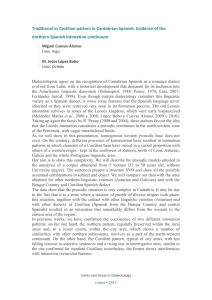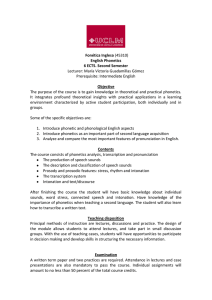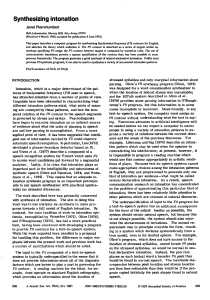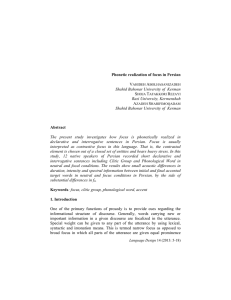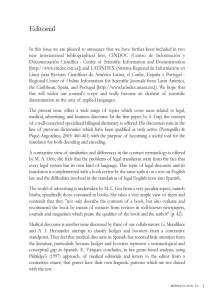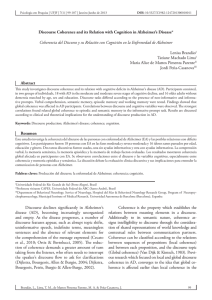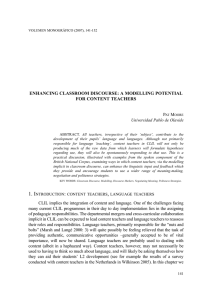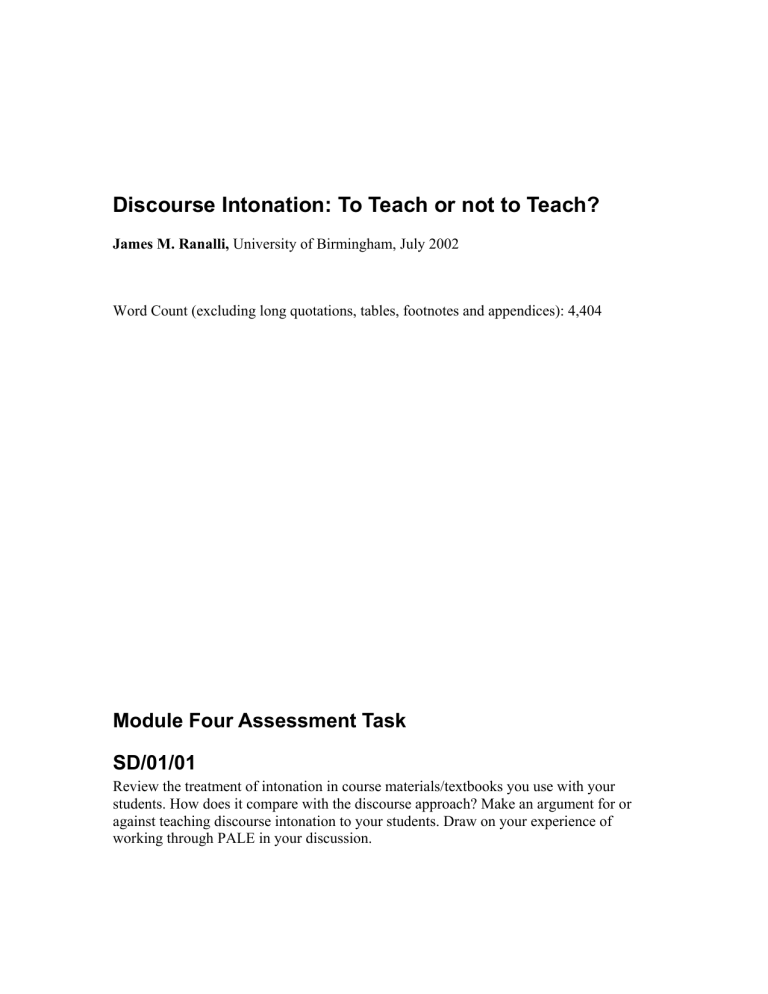
Discourse Intonation: To Teach or not to Teach? James M. Ranalli, University of Birmingham, July 2002 Word Count (excluding long quotations, tables, footnotes and appendices): 4,404 Module Four Assessment Task SD/01/01 Review the treatment of intonation in course materials/textbooks you use with your students. How does it compare with the discourse approach? Make an argument for or against teaching discourse intonation to your students. Draw on your experience of working through PALE in your discussion. 1 Introduction The purpose of this paper is to examine the theory of discourse intonation and to discuss issues related to intonation pedagogy. The paper will follow this format: First, I will define intonation briefly. Secondly, in order to provide a clear contrast to discourse intonation, I will describe a more traditional treatment of intonation to be found in the materials I have used in my classes for the last several years. In the next two sections I will outline the theory of discourse intonation and then will discuss some considerations in deciding whether and how to teach it. Finally, the paper will conclude with some observations about the broader context of pronunciation instruction in general. The basic argument here will be in favor of teaching certain elements of discourse intonation after taking into account governing conditions such as learner needs, teaching program aims, and the learning context. 2 Background 2.1 What is intonation? Intonation is usually defined more or less generally. Cruttenden, for example, seems to equate intonation specifically with pitch movement (1986: 9) while Coulthard has identified it with prosody in general (1992: 96), which would therefore include pitch movement but also loudness, length, speed, and even voice quality. Pitch, however, is the common thread running through most descriptions. Cruttenden describes pitch as the perceptual correlate of fundamental frequency, which is the continuous variation in the sounds we perceive as a result of the vibration of the vocal cords. Intonation, then, can be narrowly described as the movements or variations in pitch to which we attach familiar labels describing levels (e.g. high/low) and tones (e.g. falling/rising), etc. Another important component is the phenomenon called prominence, which is the tendency for speakers to makes some syllables more noticeable than others. This is accomplished by pronouncing them louder and longer, by assigning them a different pitch, or by articulating the phonemes (especially the vowel) more distinctly (Roach, 1 1991: 86). Prominence is also sometimes referred to as emphasis, focus, main stress, nucleus or tonic accent. Importantly, pitch level, pitch movement and prominence are all relative values. Cauldwell and Allen observe that “one speaker’s ‘mid’ pitch would be another speaker’s ‘low’ pitch” and values vary from speaker to speaker and with the context of the situation (1997: 6) This relativity is important in distinguishing intonation from melody or music, to which it is often compared. For purposes of this paper, the following broad definition of intonation will be adopted: systematic variations in pitch level, pitch movement and prominence. As will be shown, this is general enough to encompass both the discourse-based and more traditional accounts of intonational meaning to be discussed. 2.2 Why is it important? It is a common truth that the way we say something can be just as important in conveying a message as the words we use to say it. Intonation choices made by speakers carry linguistic information and the various elements of intonation are seen to perform a variety of functions. Crystal identifies six: emotional, grammatical, informational, textual, psychological and indexical (1995: 249), whereas Roach points out four: attitudinal, accentual, grammatical and discourse (1991: 163). Other descriptions have added conversation-management functions as well (see Clennel, 1997 and Wennerstrom, 1994). 2.2.1 Intonation and non-native speakers of English Especially in the case of non-native English speakers, how much does intonation contribute to successful communication? There is some debate on this question. Roach suggests that reports of miscommunication are overestimated, and that when nonstandard English creates misunderstanding or causes offence, the root of the problem is on “very few occasions” found to be intonation (1991: 168). Many would disagree, however. Pickering (2001), Clennel (1997) and Wennerstrom (1994), all working in ESL environments, cite research and anecdotal data showing the problems that intonational 2 miscues can cause between native- and non-native speakers. Clennel summarizes these as follows: 1. The prepositional content (essential information) of the message may not be fully grasped. 2. The illocutionary force (pragmatic meaning) of utterances may be misunderstood. 3. Interspeaker cooperation and conversational management may be poorly controlled (1997: 118). Furthermore, Jenkins, in arguing what is important and peripheral in intonation for nonnative speakers interacting with each other in EFL situations, says that while tones are non-vital, mistakes of prominence or “nuclear stress” are one category of phonological error which can cause breakdowns in communication.(2002: 87) 2.2.3 A conundrum for pedagogy For those concerned with English-language pedagogy, Dalton and Seidlhofer point out a conundrum: even supposing that the features of intonation are “particularly important in discourse … at the same time they are particularly difficult to teach” (1994: 73). In ELT, intonation is widely regarded as slippery. Attempts to describe it in ways amenable to instruction have proved elusive. Roach says that “of the rules and generalizations that could be made about conveying attitudes through intonation, those which are not actually wrong are likely to be too trivial to be worth learning” (1991: 168). Bradford suggests that part of the difficulty arises from the fact that intonation patterns are planned at a deeply subconscious level, so even native speakers may be unable to describe and analyze the patterns they themselves use with precision (1992: 1). And Brazil, while advocating an intonation pedagogy which highlights tones, concedes that these phenomena are difficult even for native speakers to analyze and agree on (1994: 6). Which begs the question: if intonation is so difficult, should we attempt to teach it? If so, which components? And how? The remainder of the paper will address these questions. 3 3 My teaching materials 3.1 Description The materials I have used most to teach intonation are the Headway pronunciation books, a four-level set of coursebooks written to accompany the very successful ELT series. The pronunciation books are designed to be used either as supplementary classroom material or for self-study by the learner. Intonation is treated as one of four components of the course syllabus, the others being segmentals (or ‘sounds’), words and word stress, and features of connected speech. Prominence is included in the intonation sections under the name ‘sentence stress’. 3.1.1 Intonation functions Perusing the contents map in each book, it becomes immediately clear which functions the authors assign to intonation (see Appendix). Following Roach (1991) and Thompson (1995), we can categorize these functions into four groups. ! Linguistic form-based: i.e. grammatical (the intonation of Yes/No or Wh- questions) or lexical (intonation on modifiers like really or absolutely); ! Attitudinal or Interpersonal: e.g. sounding enthusiastic, interested, polite; showing disbelief; ! Accentual: especially in contrasts, e.g. ‘special stress’, emphasizing, correcting; ! Conversation management-related: asking someone to repeat something, disagreeing strongly. Often two or more of these categories are combined into a single focus, e.g. attitudinal and grammatical (“showing interest and surprise in reply questions”) or accentual, conversation management and interpersonal (“correcting politely”). 3.1.2 Rules and generalizations Generalizations are established in Headway in one of two ways. In the case of linguisticbased features, explicit rules are given and the relationship between form and function is stated clearly. For example, in the intermediate level book (Cunningham and Bowler, 1999) one will find the following: 4 The intonation of Wh- questions normally goes down at the end … Remember to start high so that it is easier to come down at the end. (page 9) Question tags with rising intonation are ‘real’ questions, the speaker is not sure of the answer. … If the intonation falls, the speaker is not asking a question, but just asking the other person to agree. (page 48) In other cases, especially where the focus is attitudinal or interpersonal, the rules are much less explicit, or often simply absent. Thompson, labeling this the “benign neglect approach”, describes it thus: Learners are offered no rules about intonation choices. Rather, they are encouraged to acquire appropriate intonation patterns through exposure to authentic or quasi-authentic listening materials, and practice activities such as listen-and-repeat or language awareness tasks (1995: 236). For example, in the upper-intermediate book, learners must listen to dialogues of people greeting each other and indicate whether they sound neutral or disinterested, friendly and interested, or “excited and very pleased to see each other” (1999: 8). They then practice the dialogues in pairs. 3.1.3 Methodology The Headway exercises consistently follow a reception-to-production format. Students are usually asked to listen to a short sample (often stand-alone sentences or dialogues with minimal contexts provided by pictures) and then answer questions, e.g. “Which speaker sounds more enthusiastic?” The exercises usually end with learners doing some controlled or freer productive practice. Pictures, pair work and tongue twisters are employed to make the material communicative and engaging. The authors appear to have deliberately avoided linguistic terminology, presumably on the grounds that it will be an encumbrance rather than a help. Indeed, the word pitch appears only once in the whole series and no mention is ever made of tones. 3.2 Commentary Headway is more thorough than most coursebooks in its treatment of intonation. The exercises in particular are well-written and well-presented. Nevertheless, the material 5 suffers from many of the criticisms that can be made about traditional intonation pedagogy. Firstly, grammar-based rules are hard to reconcile with what happens in real conversational data. Cauldwell and Hewings (1996) and Thompson (1995) have pointed out the difficulties with identifying question types with particular pitch patterns. They note how real conversation data abounds with Wh- questions containing rising tones and Yes/No questions which fall. Cauldwell and Hewings further cite frequent real-life exceptions to rules for the intonation of lists, another common coursebook focus (1996: 328). To be fair, Headway’s authors do deal with the case of rising Wh-questions in the upper-intermediate book, but they treat it as an exception to the grammatically based rule. As we shall see, a better explanation is made possible by discourse intonation. Secondly, many of the book’s generalizations about attitudinal functions suffer from those criticisms already mentioned in Roach. They are so broad as to be probably true of many other languages and “foreign learners do not find it easy to learn to use intonation through studying them” (1991: 168). Following Cauldwell and Hewings, we can find additional problems as well. While Headway does indeed cover more ground than most, all its generalizations taken together will still account for “only a fraction of intonation choices made in the language as a whole” (1996: 333). Furthermore, it is hard for students to see how the rules interrelate. For example, in Headway, the fall-rise tone is taught in all four levels of the course; it is associated with certain linguistic forms and presented as one way of showing politeness or enthusiasm (see table below). The learners’ attention, however, is never drawn to the fact that this is the same pattern reoccurring, and what significance this might have. 6 Level Elementary Unit/Focus Unit 12: Sounding enthusiastic Rule or generalization To show enthusiasm, the voice starts high and goes down and then up again … Pre-intermediate Unit 5: Hearing the difference between polite and impolite offers To make a polite offer your intonation should go up on the stressed word, fall, then go up a little at the end ... Intermediate Unit 3: Showing interest through short questions To show that you are interested and want to hear more, your intonation should start high, go down, and then go up at the end … Upperintermediate Unit 9: Polite intonation in indirect questions To make these questions sound polite, your voice starts high, comes down a lot, and goes up a little at the end … Figure 1: Functions of the fall-rise tone as described in the Headway Pronunciation course I have had mixed results with Headway in my intonation teaching. Often the books make for good classroom activities, but in real-time communication the learners quickly revert to old patterns. Use of tones away from the norm in Wh- questions or question tags, for example, seems especially resistant to change. And the books’ frequent injunctions to exaggerate the intonation or “sound enthusiastic” are sometimes met with complaints that the tasks are inauthentic, silly and may suggest requiring students to alter their personalities. In brief, the traditional approach as exemplified in Headway falls short in a number of important ways. Having considered its deficiencies, let us now turn to the alternative provided by discourse intonation. 4 Discourse intonation Discourse intonation had its beginnings in the formal descriptions of Halliday but was developed into a complete theory by Brazil (Coulthard 1985). In its most elemental form 7 this theory states that all intonation choices made by speakers are a function of the discourse developing between them. Intonation helps speakers show how each of their utterances is related to other utterances and to the discourse as a whole. Moreover, all intonation choices are tied to the context in which they occur. In contrast to the linguistic universals of grammar-based descriptions, it would be impossible in the discourse approach to isolate a stretch of speech from its context and make any generalizations about intonational meaning. 4.1 Formal components Discourse intonation proposes a simple and flexible system with a small and finite number of choices, among which are the formal components Brazil identifies. First and foremost is the tone unit, which is the basic building block of speech (and which is used widely as a unit of phonological analysis in most theories of intonation, though Brazil presents his own version.) The tone unit in Brazil is distinguished by containing a single complete pitch pattern and consisting of proclitic, tonic and enclitic segments. (Coulthard 1985: 101). Additionally, there are four sets of options associated with the tone unit – prominence, tone, key and termination – each of which adds a different type of information. Following Coulthard’s description, these are summarized in the table below: Feature Description Prominence Distinguishes marked from unmarked syllables … given to a property that is not inherent (like word ‘accent’) but only associated with a word by virtue of its function as a constituent part of a tone unit. A tonic syllable is one which is prominent but on which there is also major pitch movement. Tone Pitch movements distinguished by their particular direction or contour. In Brazil there are five: falling, rising, fall-rise, rise-fall and level. Key A relative pitch level chosen by speakers for each tone unit, from three choices, low, middle and high. Key choices are made and recognized with reference to the key of the immediately preceding tone unit. 8 Termination Also a low, middle, or high pitch-level choice, made by speakers at the beginning or end of a tone unit. Termination choices relate to the key choices of the preceding and following tone units, whether these are spoken by the same person or an interlocutor. Figure 2: Description of formal components in discourse intonation theory, from Coulthard 4.2 Common ground In DI much of the significance of the interaction between speakers relates to common ground. Underhill explains this idea as “the knowledge and experience that the participants think they share about the world, the topic and each other in terms of ideas, emotions, attitudes, viewpoints, etc. at any given point in the interaction”(1994: 86). Discourse proceeds and intonation choices are made on the basis of the speaker’s assessment of what he and his listener or listeners share as common ground – or how he wishes that state of shared experience to appear since, as Underhill notes, common ground is “exploitable by the speaker to his advantage.” 4.3 Proclaiming and referring tones Tone descriptions in DI follow from the idea of common ground. Underhill continues, Information which is additional to the common ground is marked by a pitch that finishes with a falling movement, and is given the name proclaiming tone. Information which is given as already shared and part of the common ground is marked by a pitch that finishes with a rising movement and is given the name referring tone, since it refers back to something already shared or negotiated (1994: 86). More marked versions of these tones exist – the rising tone and the rise-fall tone – by which speakers can signify a dominant position in the discourse. Other tones choices include an oblique falling tone and a level (or ‘zero’) tone, both of which are used for utterances not meant to be part of direct discourse. 4.4 Relevance and impact of discourse intonation Discourse intonation is important because, by many accounts, it provides the most satisfactory explanation for the intonation choices speakers make. The theory is attractive because it is simple and yet has a powerful explanatory force. It not only can account for 9 frequently occurring patterns in conversation, but for the exceptions to those patterns as well. It has a current appeal now because of its “top-down” and communicative orientation, foregrounding as it does the distinctiveness of particular speakers and contexts rather than linguistic universals. Perhaps because of this, it has become more and more accepted in recent years, as evidenced by the number of coursebooks and other teaching materials incorporating it (see, for example Bradford, 1992, Brazil, 1994 and Underhill, 1994). 4.5 Teaching discourse intonation: the example of PALE One approach to teaching discourse intonation is the course prepared by Brazil himself, called Pronunciation for Advanced Learner of English. Keeping with the spirit of DI, the teacher’s book says the focus is on encouraging learners to “see pronunciation from the point of view of how it can best enable them to make their meanings and intentions clear to the listener” (1994: 2). PALE is a thorough introduction to discourse intonation theory, although some items have been left out in the interest of pedagogy (e.g. termination, the rise-fall and oblique falling tones). Learners are instructed in the forms and functions of tone units, prominence, tonic syllables, and tones. Unlike Headway, PALE makes much use of linguistic terminology and a transcription system, because according to Brazil these are the “best way of pinning down the otherwise elusive nature of intonation and so avoiding the vagueness that can so easily undermine one’s confidence when working with it” (1994: 5). The methodology is inductive. Students are encouraged “wherever possible to discover ‘rules’ and other regularities for themselves, and formulate them in their own terms, before these are stated in their institutionalized form.” (1994: 4). When stated, however, the generalizations are clear and explicit. For example, There are two different tones which you can use when you want to say that what you are saying is not news: a rise and a fall-rise. Both of these tones tell your listener the same thing: that the tone unit refers to a part of the message that you both know about already. For this reason, we call them both referring tones (1994: 3) 10 Each unit begins with a listening text which learners first process for meaning, and which provides a context and examples for analysis and discussion. Exercises which follow usually involve students analyzing tone units from the tapescript and deciding why, for example, a speaker chose a referring tone in one particular instance – that is, how could the information be said to be given, or part of the shared background. In addition to listening, learners do some production-oriented exercises also. These usually involve simply repeating tone units from the tapescript, although later in the book there are a few exercises which require learners to choose an appropriate tone based on the context. Work on segmentals, coordinated with the intonation material, also occurs in each unit. 5 Discussion and argument Despite DI’s attractiveness as a theory, it does not necessarily mean we can or must teach it. Insights and discoveries which advance the field of descriptive linguistics may not translate well into language pedagogy (as some have argued recently about corpus linguistics). Guiding principles are needed. Underhill has proposed three for teaching intonation. “Ideally,” he writes, … what we are after is a system that: • Is learnable; • Accounts for what native speakers do and don’t do; • Has a limited set of rules that enables learners to develop valid generalizations on which to base their own interpretation and production (1994: 3). DI looks promising in terms of the second and third criteria, but the first is debatable. There are some important issues related to the learnability of discourse intonation that must be acknowledged. 5.1 Problems with teaching discourse intonation 5.1.1 Difficulty distinguishing tones 11 Part of the difficulty of teaching intonation, particularly tones, arises from the challenge of even identifying them. Cauldwell and Allen note that “people vary in their ability to hear intonation patterns, and there are quite often disagreements between trained listeners about what they hear in a speech sample” (1997: 2). If even native speakers have trouble identifying tones in a recorded transcript, we can imagine the difficulties learners will face not only in distinguishing but also producing them. It may come down to individual aptitude. In the case of Elisa (not her real name), the student I privately tutored using the PALE course, she was still having difficulty distinguishing a fall-rise from a falling tone after ten hours of instruction and practice. Naturally her attempts to produce these tones were often less than successful. 5.1.2 Subtlety of the given/new distinction Dalton and Seidlhofer assert that elements of discourse intonation may be “too subtle to survive in practical teaching” (1994: 63). One such element could be the distinction between given and new information. Levis says that what is given and new is often “not transparent” and there are irregularities and exceptions. For example, learners must understand that new information does not mean all new information but rather the last piece of new information in a phrase (2001: 48). “While new and given information are valuable concepts for analysis,” Levis concludes, “students will often have difficulty applying them.” 5.1.3 Planning time A related problem is the need for planning time, which Levis calls a “major limitation for learner” (2001: 49). Speakers engaging in real-time communication have to make decisions as they go about which information to highlight, while at the same time responding to what they hear. For someone interacting in a second language, the burden of intonational, as well phonemic and lexico-grammatical encoding, may overwhelm one’s processing capacity. 12 5.2 What to teach, and how? None of this is to suggest that teaching discourse intonation is impossible, but it will certainly present challenges. A common-sense approach might be to divide up the components of intonation and determine which of them we might usefully and fruitfully teach, after considering our learners’ needs and the realities of our teaching contexts. A few observations along these lines follow. 5.2.1 Prominence For Dalton and Seidlhofer, prominence is “maybe the most important function of intonation, and almost certainly the most teachable one” (1994: 81). Research seems to support this claim. Wennerstrom conducted a study which found that non-native speakers tend to give “relatively equal prominence to items, regardless of their importance to the information structure of the discourse” (1994: 44). Jenkins cites data from her own research (2000, 2002) which shows that mistakes of prominence (or “nuclear stress”) are responsible for serious breakdowns in communication between non-native speakers. In terms of learnability, my own experiments with PALE offered some corroboration. Elisa found the sections on prominence to be the most illuminating, as they contradicted rules she had learned at school (namely that prominence is always placed on the lexical words in a sentence). She seemed to grasp the new concepts quickly and her ability to use prominence selectively according to context appeared to have improved somewhat by the end of the course. It would seem that prominence can be taught even at lower levels (as happens in the Headway materials). However, a consciousness-raising approach, like that employed in PALE, may not be the most appropriate choice. Jenkins has noted how “learners seem to acquire [prominence] relatively quickly for receptive purposes but do not acquire it productively until considerably later, if at all” (1998: 122). One might argue that the “thorough, systematic teaching” of prominence advocated by Jenkins could best be achieved through a combination of consciousness raising for receptive purposes, followed by more production-oriented exercises like those in the Headway materials. 13 5.2.2 Tones Given the difficulty of working with tones, we must seriously consider whether or not to teach them if it means great potential for student frustration and failure. Here the question of learner needs and context becomes important. Jenkins argues that for a great number of English learners, their primary interaction in the language will be with other nonnative speakers who do not use the English intonation system either receptively or productively. She concludes, therefore, that there is no point in teaching it (1998). On the other hand, in ESL situations where learners have dealings with native speakers, tone choice may be considered very important. Pickering reports on research into interactions between international teaching assistants in US universities and their native-speaking students. She concluded that the ITAs’ tone choices “obfuscated the information structure and frequently characterized these speakers as unsympathetic and uninvolved” (2001: 233). Hewings (1995) shows how the use of inappropriate falling tones by foreign learners when contradicting native speakers can give the impression of deliberate rudeness or animosity. Clearly, in certain ESL situations there is a need for intervention in the area of tones. The question will be how to address it. A discourse approach would seem possible only with higher-level learners, who will not only need to make sense of the longer texts required to teach DI but also to use the metalanguage needed to discuss the subtleties of tone phenomena and transcription. The consciousness-raising approach would seem appropriate here, as it entails the use of texts necessary for discoursal analysis, and also allows space for intonation to “emerge” in its own time, in contrast to more goal-oriented, production-based methodologies. The need to have realistic goals will also be important. 5.2.3 The tone unit The tone unit itself has been identified as a potentially useful tool to teach, in that it helps both speakers (with planning time) and listeners (with decoding time), and resembles much more closely a basic unit of spoken language than does the sentence (See Cauldwell, 2002: 7). However, my experiments with PALE showed that the value of this 14 tool can be diluted by confusion over tone-unit boundaries and pauses. In cases where transcription showed two tone units together and yet no pause was heard, Elisa had trouble understanding why a single stretch of speech should be thought to consist of two parts. A solution might be to teach Gilbert’s notion of “thought groups”, which retain the planning and decoding benefits of tone units but take pauses as their boundaries (1993: 108). (This solution is not simply a concession to pedagogy. Brown and Yule note several reasons why pause-defined units might better serve applied linguistics than tone units, including the fact that pauses are “readily identifiable” and are also measurable by instrumentation (1983: 161)). 5.3 Related issues 5.3.1 The need for integration Discourse intonation-based coursebooks like those produced by Brazil and Bradford are admirable for their thoroughness and systematicity, but are impractical for most teaching situations for a variety of reasons, not least of which is time. My studies with Elisa confirmed such supplementary books are extremely time-consuming and may require special courses focusing on pronunciation alone. Therefore, teachers would do well to integrate DI work into their current approach rather than bring in special materials (as has been suggested by Underhill, 1994: 93 and Kenworthy, 1987: 117). In particular, opportunities for linking pronunciation and discourse with listening instruction have been addressed in recent articles by Field (1998, 2000) and Cauldwell (2000, 2002). To be sure, analyzing and adapting existing materials to teach discourse intonation will put a teachers skills to the test, but the benefits will be great. 5.3.2 Alternative approaches Short of adopting a complete DI orientation, teachers might also consider incorporating elements of the theory into the pronunciation work they already do. As already mentioned, Cauldwell and Hewings support supplementing the traditional intonation rules of ELT textbooks with discourse-based explanations, “to give teachers alternative, and more productive, ways of explaining to students” the exceptions to such rules (1996: 15 334). Thompson suggests adding a discourse element to the traditional pedagogy of Yes/no question intonation by teaching the notion of “conducive or non-conducive”; that is, asking the listener to confirm expectations or not based on the “communicative intention of the speaker in a particular situation” (1995: 238). Pickering identifies several useful intonation features which might be taught functionally or lexically to university ITAs. These include rising comprehension checks (e.g. Right? OK?), and the “template technique”, a level tone followed by a short pause to encourage students to ‘fill in the blanks’, which provides a more acceptable alternative to the falling tones many ITAs use when dealing with incorrect responses (2001: 245). Additionally, Chun (1998) reminds us of the role technology can play, by virtue of advances in acoustic signal analysis software and new applications of it for teaching discourse intonation. 6 Conclusion To sum up, discourse intonation presents interesting possibilities to ELT in that it is simple, elegant and explains a lot. Nevertheless, intonation is likely to remain what Dalton and Seidlhofer have called the “problem child” of pronunciation teaching because of its inherent difficulty. Teachers and learners will still need to maintain realistic goals when addressing intonation whether they use DI or not. It will be helpful to keep a wider perspective on the issue of pronunciation teaching. In doing so one will see that discourse intonation is but one part of a larger movement away from traditional, bottom-up, phonemic-based approaches, and towards a more top-down methodology concentrating on global meaning and communication (Chun 1998: 61). There are other starting points besides discourse intonation. Thornbury (1993) has proposed a methodology based on voice-setting, while Jones and Evans (1995) promote the idea of teaching pronunciation through voice-quality. The goal in all cases is a phonology for teaching which will emphasize communicative function rather than linguistic form. 16 The search for such a pedagogy will best be accomplished if teachers avoid all-or-none positions and the common tendency in ELT to dispose of older approaches wholesale to make way for new theories. A gradual evolution of pronunciation teaching, which assimilates insights found along the way into approaches that have worked before, is more likely to yield success than will infrequent and violent revolutions. To make such an evolution possible, teachers would do well to adopt an experimental posture and use action research to find the best solutions for pronunciation teaching. Common sense should guide us in finding what works and what helps our learners achieve their goals. 17 Appendix Intonation-focused exercises in the New Headway Pronunciation Course series Elementary Unit 2: Introduction to sentence stress Unit 3: Introduction to intonation: up or down? Unit 5: Sounding polite Unit 7: Intonation in Wh- questions Unit 9: Special stress; Polite requests Unit 12: Sounding enthusiastic Pre-intermediate Unit 1: Intonation in Wh- and Yes/No questions Unit 4: List intonation in the game ‘My sister Sally when to the summer sales …’ using the clothes vocabulary Unit 5: Hearing the difference between polite and impolite offers Unit 8: Questions with or, with friendly and unfriendly intonation in formal and informal dialogues Unit 9: Showing interest and surprise with short reply questions in a dialogue Unit 13: Corrective stress in addresses and phone numbers Intermediate Unit 1: Intonation in Wh- questions Unit 2: Intonation in single words Unit 3: Showing interest through short questions Unit 4: Making polite requests with Could and Would; Responding to requests Unit 5: Emphatic stress Unit 6: Showing degrees of enthusiasm Unit 7: Question tags with falling intonation Unit 8: Intonation with really and absolutely Unit 9: Sentence stress with So do I, etc. Unit 10: Correcting politely with present perfect continuous Unit 11: Rising and falling intonation in question tags Unit 12: Showing disbelief with reported speech Upper-intermediate Unit 1: Hellos and goodbyes Unit 2: Exclamations with countable and uncountable nouns Unit 3: Rising and falling intonation in questions Unit 4: Wh- questions with up intonation Unit 5: Special stress Unit 6: Sentence phrasing with defining and non-defining relatives clauses Unit 8: Exaggeration and understatement in short dialogues Unit 9 Polite intonation in indirect wh- questions Unit 12: Emphatic forms in short dialogues 18 References Bowler, B. and Cunningham, S. (1999). New Headway Pronunciation Course (Upperintermediate). Oxford, Oxford University Press. Bradford, B. (1992). Intonation in Context. Cambridge, Cambridge University Press. Brazil, D. (1994). Pronunciation for Advanced Learners of English (Teacher's Book). Cambridge, Cambridge University Press. Brown, G. and G. Yule (1983). Discourse Analysis. Cambridge, Cambridge University Press. Cauldwell, R. (2000). "Grasping the nettle: The importance of perception work in listening comprehension." Eger Journal of English Studies 1. Cauldwell, R. (2002). Phonology for Listening: Relishing the messy, Published on the internet at http://www.speechinaction.com. Cauldwell, R. and M. Allen (1997). Phonology. Birmingham, The Centre for English Language Studies, The University of Birmingham. Cauldwell, R. and M. Hewings (1996). "Intonation rules in ELT textbooks." ELT Journal 50(4): 327-334. Chun, D. (1998). "Signal Analysis Software For Teaching Discourse Intonation." Language Learning & Technology 2(1): 61-77. Clennel, C. (1997). "Raising the pedagogic status of discourse intonation teaching." ELT Journal 51(2): 117-125. Coulthard, M. (1985). Intonation. An Introduction to Discourse Analysis. M. Coulthard. London, Longman. Coulthard, M. (1992). The significance of intonation in discourse. Advances in spoken discourse. M. Coulthard. London, Routledge. Cruttenden (1986). Intonation. Cambridge, Cambridge University Press. Crystal, D. (1995). The Cambridge Encyclopedia of the English Language. Cambridge, Cambridge University Press. Cunningham, S. and B. Bowler (1999). New Headway Pronunciation Course (Intermediate). Oxford, Oxford University Press. Dalton, C. and B. Seidlhofer (1994). Pronunciation. Oxford, Oxford University Press. 19 Field, J. (1998). "Skills and strategies: towards a new methodology for listening." ELT Journal 52(2): 110-118. Field, J. (2000). "Finding one's way in the fog: listening strategies and second-language learners." Modern English Teacher 9(1). Gilbert, J. (1993). Clear Speech. Cambridge, Cambridge University Press. Hewings, M. (1995). "Tone choice in the English intonation of nonnative speakers." International Review of Applied Linguistics 33. Jenkins, J. (1998). "Which pronunciation norms and models for English as an International Language?" ELT Journal 52(2): 119-126. Jenkins, J. (2000). The Phonology of English as an International Language. Oxford, Oxford University Press. Jenkins, J. (2002). "A Sociolinguistically Based, Empirically Researched Pronunciation Syllabus for English as an International Language." Applied Linguistics 23(1): 83-103. Jones, R. H. and S. Evans (1995). "Teaching Pronunciation through Voice Quality." ELT Journal 49(3): 244-251. Kenworthy, J. (1987). Teaching English Pronunciation. Harlow, Longman. Levis, J. M. (2001). "Teaching focus for conversational use." ELT Journal 55(1): 47-54. Pickering, L. (2001). "The Role of Tone Choice in Improving ITA Communication in the Classroom." TESOL Quarterly 35(2): 233-255. Roach, P. (1991). English Phonetics and Phonology: a practical course. Cambridge, Cambridge University Press. Thompson, S. (1995). "Teaching intonation on questions." ELT Journal 49(3): 235-245. Thornbury, S. (1993). "Having a good jaw: voice-setting phonology." ELT Journal 47(2): 126-131. Underhill, A. (1994). Sound Foundations. Oxford, Heinemann. Wennerstrom, A. (1994). "Intonational Meaning in English Discourse: A Study of NonNative Speakers." Applied Linguistics 15(4): 399-420. 20

